
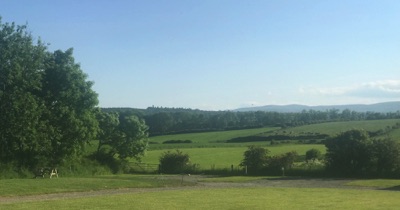
We were up relatively early, packed up the van and then made use of all the campervan services at Psycodlyn, such as grey water disposal, toilet cassette emptying and water-tank filling, and then headed north and back into England. We were heading to a campsite near Penrith, so that we could go visit another friend from Marysville days, who lived and worked nearby. While we were passing close to several large cities, such as Birmingham, Liverpool and Manchester, we had no intention of visiting them (and given the increase in traffic on the motorway as we got close to each of these cities, I'm glad we didn't try to go into them). However, as we went through these areas, I was reminded by names on direction signs (e.g. Huddesfield, Wakefield, Wigan etc) of my time as a kid listening to radio broadcasts in the middle of the night as the touring Kangaroos Rugby League team played matches against these local teams. We were indeed driving through legendary Rugby League territory.
As we drove further north, we noticed two things. Firstly, we started seeing lots and lots of stone fences. Clearly, the early farmers would have spent lots of their time clearing stone out of their paddock soils. But at least they made good use of them by building stone walls.
Mon 5 June - head north, skip cities, CrossfelsCampsite, working farm, beer, sunset
We also noticed that the landscape became increasingly barren, with barely a tree and lots of "nude" hilltops. I could now understand where the early English settlers in Australia got the idea that they had to scarify the land in order to turn it into "productive farming land".

We also saw lots of wind turbines, so at least they were making the most of their often inclement weather by using the wind to generate electricity.

As we approached Penrith, Google Maps instructed up to leave the motorway in order to get to the campsite at Crossfels, and along the way we saw many properties where new trees were again being planted. Hopefully this process continues into the future.

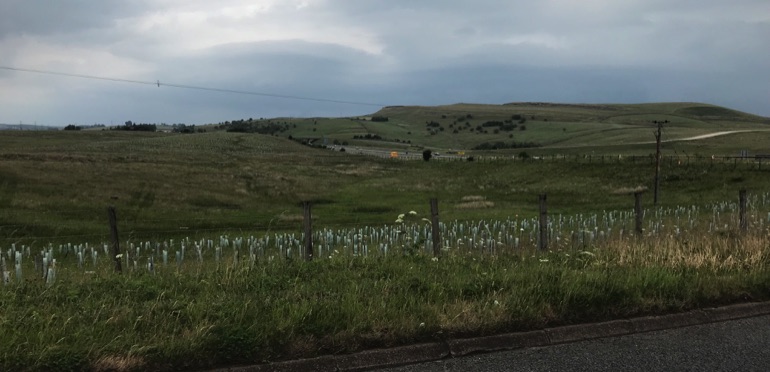
After a circuitous drive, in which we saw lots of interesting scenery, we arrived at the Crossfels Campsite, to be greeted by the very friendly Craig (who I had read about in several reviews of Crossfels in the campsite apps I had downloaded). The Crossfels Campsite is set up in the middle of a working farm, as demonstrated soon after we arrived as Craig went off to spray manure on the paddocks at the back of the campsite. For those petrons who came from the city, this might have been a bit of a surprise, but for us (as 20 year residents of rural Taggerty) it just reminded us of home. We got a nice campsite, with power, water and a picnic table on green grass, and with a good view over the surrounding farming paddocks. I sat in the sun at the picnic table with a cold beer after the long drive from Wales.

After dinner, I went for a walk along the edge of the surrounding paddock (I love how, in the UK, people are allowed to walk along the edge of private farm paddocks and are even provided with gates and stiles to climb fences to cross over to the next paddock). As the day drew to a close, I got a nice sunset photo between two trees in a neighbouring paddock.

We woke late to a cool, cloudy then sunny morning - another typical UK summer morning, except it wasn't raining. Actually, the weather has been very cooperative so far, but we're waiting for the change to come. After breakfast, we unpacked the bikes from the rear of the van, and rode a few kilometres via several back roads to Brougham Hall, on the edge of the town of Penrith, when our friend Ellen had set up her new studio and shop since moving back from Marysville. We had no idea what the "Hall" would look like, but when we got there we were pleasantly surprised - the front door was the first of many other surprises.
Tues 6 June - summer, Brougham Hall, Ellen, Penrith, fuses, iPhone holders

The Hall was once a fortified home, dating back to the 14th century. After outliving its original purpose, it was partially demolished in the 1930's, then left derelict for many decades until restoration was commenced in the 1980's by a new owner. Half of the site is now functioning as an arts&crafts precinct, with several workshops, studios and shops, overtopped by some residential premises.


It was in this restored part of the Hall that we discovered Ellen and her pottery workshop.

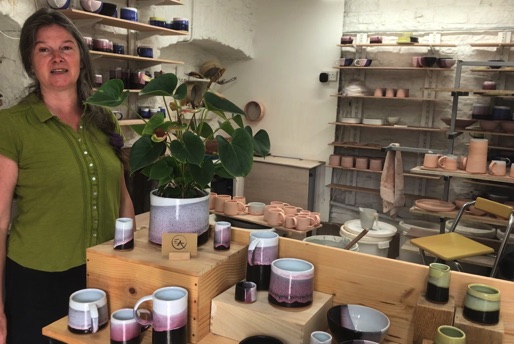
We chatted over several coffees for a couple of hours, then agreed to catch up again on our way back from Scotland, before leaving her to finish off some pieces that she was preparing for a market on an upcoming weekend. But not before buying a couple of coffee mugs from her as a memory of this day, and to fill a gap in utensils for the van. We then went to expore some of the other shops at the Hall, and were very impressed by the linocut studio and its fabulous range of fabrics and items with linocut art (some of which we also bought before heading back to Crossfels for lunch).

While talking with Ellen, we asked about the proper pronunciation of Brougham. We had been calling it "Brorm" or "Brome" until now. We also realised that there was a nearby town called Brough, which we had heard people referring to as "Bruff". Ellen told us the official pronunction, as handed down by the families who originally owned the fortified home, and on the way out we saw a door with a big hint as to how to pronounce Brougham Hall!
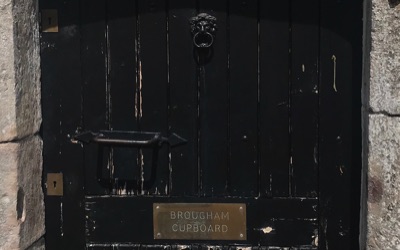
After lunch at Crossfels, we were on our bikes again to further explore the area, especially Penrith. On the way, we passed Brougham Castle, a 13th century castle situated of the banks of the River Eamont. Like many of the castles we have seen, it is a mixture of ruins and restoration, with just the %restored different for each castle.
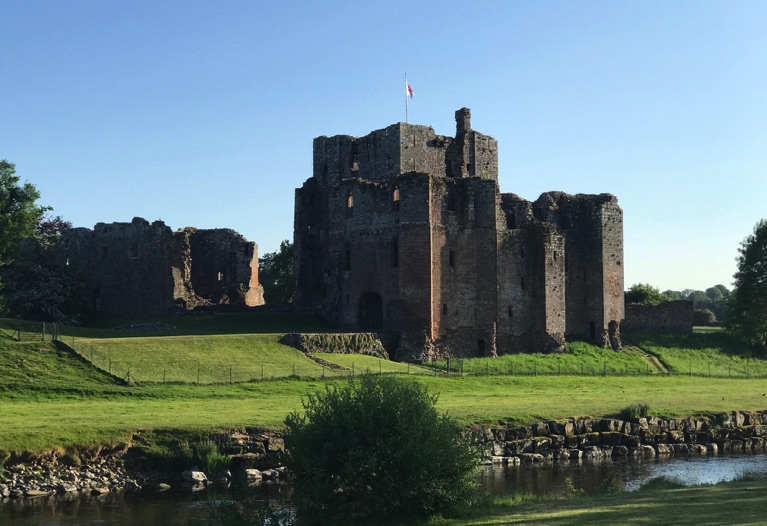
We then continued into Penrith through several residential areas, and despite the cheery welcome, we never did find the old part of the town, although we did find the old Penrith Castle, another combination of ruin and restoration.


Despite not finding the old part of town, we did find an auto and bike parts store, where I managed to buy more blade fuses than I will ever need in my lifetime, and also a couple of holders for our iPhones to use on the bikes. I liked the simple rubber one I got for mine, since it was small, easy to insert and remove the iPhone (with its protective case), and could be left on the bike handle bar when not being used.
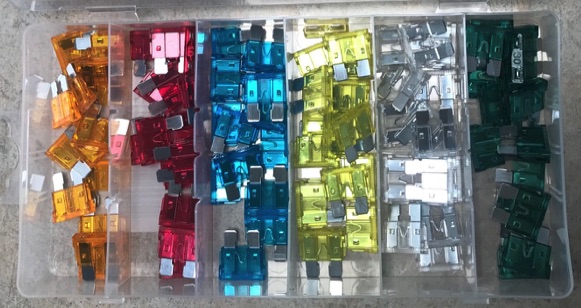
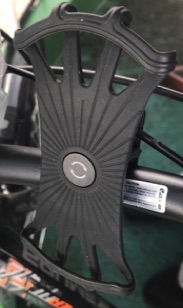
We headed back to Crossfels for the last time today, where we had a relaxed dinner in the sun, followed by coffee from our new Ellen Pogson mugs. It was still dusk till about 2330h.

The morning was cold, then turned to sunny, so we decided to take the advice of a few people and go visit nearby Lowther Castle. So we were on our bikes again, and heading to the castle via Brougham Hall. On the way, we were passed by four cyclists (on normal bikes) going much faster than us on our eBikes. However, we caught up with them at an intersection as they stood around wondering about which way to turn. Since, we had been this way a few times now, we stopped to assist them. It turned out that they were four New Zealanders who were on the way up to John O'Groats, at the very top of Scotland. We talked about their trip and the various options available to them at this intersection, and since we had enjoyed Brougham Hall so much yesterday, we advised them to go there (and say hello to Ellen if they saw her). They took our advice and headed off, and we followed them, then said goodbye once they reached the Hall, and we continued on to Lowther.
We crossed over the River Eamont and saw the sign for Lowther Castle, but the road was blocked by two large iron gates, with two large security guards sitting in a nearby tent. As we wondered what this meant, we saw a car approach and and the driver showed something to the guard, and was then allowed through the gates. So we realised it was not impossible to gain entry, so we cycled up to them and asked if we could enter, and they were very friendly and said it was fine for perdestrians and cyclists to enter, but only cars with permits could enter. So we thanked them and headed onwards.
The road was in excellent condition and passed through some very nice forested areas along the River Eamont, and then past some holiday homes (which must have had permits to get their cars in), and then through a camping area, after which the road changed to a cycle path. After crossing the River Eamont again, we entered the grounds of Lowther Castle, and ten minutes later the castle appeared on the horizon. And what an impressive sight it was!
Wed 7 June - Lowther Castle, history, daffodils, gardens, Utopia, pans, WTC final
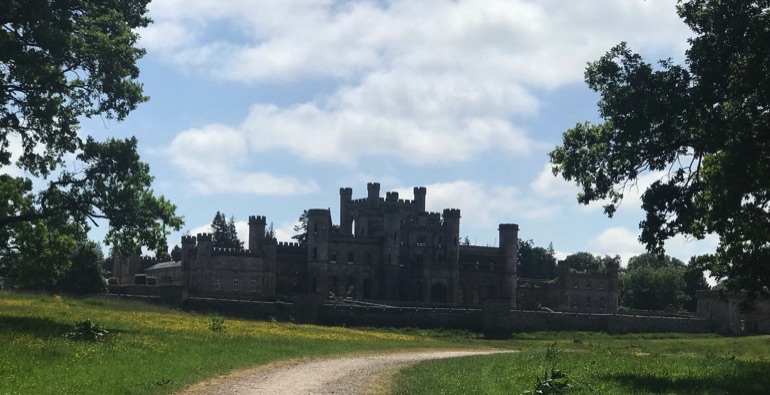
On getting closer to the castle, it looked even more impressive.
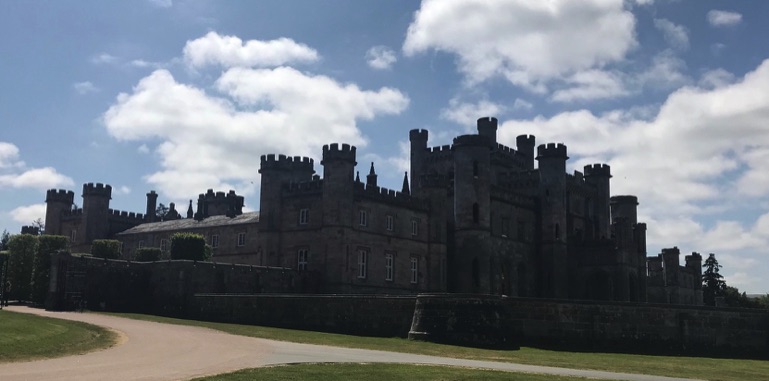
We entered via a gate in the outer wall, and then sat in the outdoor cafe having a cool drink, while we absorbed the atmosphere of the castle. It was truly impressive, and this was only the castle building. We had heard that the gardens behind the castle were even better. So we bought our entrance ticket, and upon entry we found we were in a museum describing the history of the castle and of the people who lived in the castle over the centuries, including "The Yellow Earl", whose profligate lifestyle depleted the family fortunes, and almost brought Lowther Estate to its knees. Luckily several successive generations gradually restored the castle and the family reputation, enabling the current Lowther Castle to survive in the way it has.
As we left the Museum area in the restored castle, we realised that much of the castle consists only of the outer walls (for appearance sake), with the rest of the interior being a hollow shell (like many other English castles).

As we walked out of the museum area and towards the back of the castle, we got another great view of the castle.

While the building itself was spectacular, Lowther Castle is equally well-known for its gardens out the back of the castle. We were particularly interested in a display of daffodils that had been described to us by Ellen at Brougham Hall. But these were daffodils with a difference, as all 10,000 of them were sculptures created by artists at Brougham Hall, in line with an idea created by the current owner of Lowther Castle.

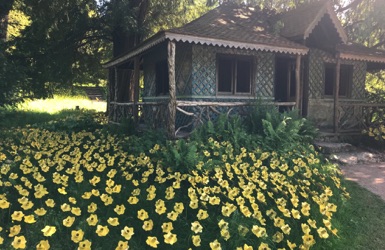
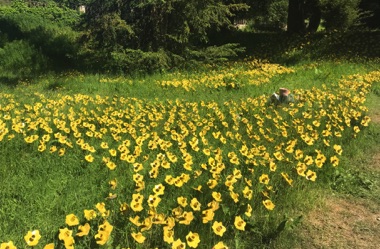
We thoroughly enjoyed our walk around the gardens, some of them relatively formal, like the rose garden, and others which were very natural, like this multi-coloured display around a small lake.
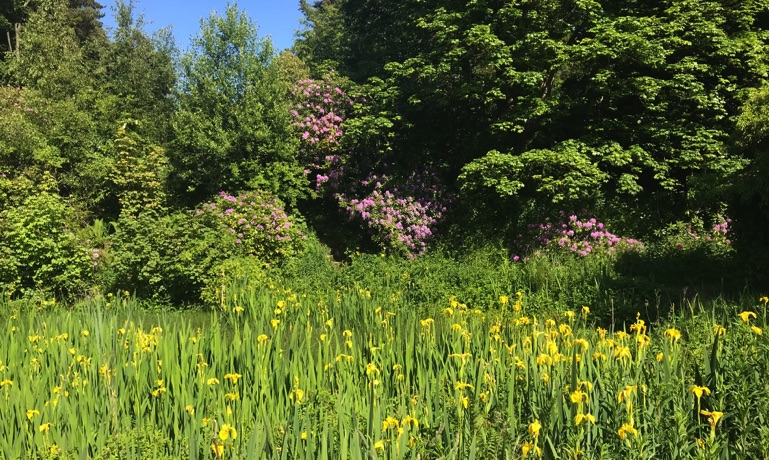
We continued to walk and found a little cottage with a fabulous view over the surrounding countryside.

We could have continued to explore for much longer, but the day was drawing to a close and we were the last visitors to leave the gardens as the staff waited to lock the gates. On the way out, we saw that it was possible to buy a Season Pass instead of a Daily Ticket. If we lived in this area, we would definitely buy the Season Pass, because there is so much to see and do here, and is a wonderful place to come for a restful day or to show friends around the castle and gardens.
We rose early, ready for our departure from Crossfels to head further north. As we were preparing the van, Craig came by on one of his regular visits during the day, and I got into a long conversation with him, when we discovered that we both had backgrounds in Civil Engineering; him in Water Resources and me in Transport Planning. But we had to get moving, so we promised to continue the conversation when we returned to Crossfels on our way south after our visit to Scotland, since we had arranged to catch up with Ellen again on our return trip.
But today we had a very different objective in mind. On our trip north, I was thinking about my family history, and remembered that my grandfather Isaac was born somewhere in the north of England. So I emailed my niece Lisa, who has taken on the role of the family genealogist, to see if she knew where Issac had been born. She replied that he had been born near Carlisle, and she sent me some details of the limited information she had been able to put together about Isaac. Since Carlisle was the next biggish town to the north of Penrith, we decided to head there for the day, and to visit the Carlisle Archives, which Craig and Liz had told us would be the best place to find further information.
So it was off to the Archives Building we went, and were pleased to see that it was easy to find, and also had plenty of parking, big enough for the van. We went to the Reception Desk and explained our situation, and were directed to a lady in the adjacent public room, where many other people appeared to be doing searches. She explained the situation to us, and how we could use their licence for Ancestry.com to search various records such as birth, death and marriage certificates, as well as the British Census which was carried out every 10 years in years ending in "1". Since we knew that Isaac had been born in 1872, that gave us a starting point and off we went searching through Census records and maps. Unfortunately, there were many people called Isaac Richardson, and so the Census Records were not conclusive.
Thurs 8 June - Craig, Carlisle Archives, Isaac, Blaetarn Farm, Hadrians Wall
We headed back to Crossfels Campsite on our bikes, and met up with Craig and Liz at the entrance, where we had a long talk about their development of the campsite, the building of their new home, and their plans for solar installations and other improvements. We then returned to the van, where we relaxed in the late afternoon sun and then enjoyed one of Rita's homemade pizzas for dinner. Afterwards we watched another episode of Utopia (on Iview via our VPN). While Rita did some more practice on her pans, I noticed on my news feed that Australia was going well on the first day of the World Test Cricket Championship Final against India at 3-321 at stumps.

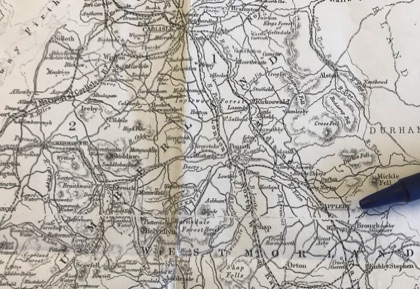
But as far as we could see, there was only one Isaac Wilson Winters Richardson born in 1872 in the Carlisle region, and so we put in an order for a copy of his Birth Certificate (unfortunately we were not able to view it online, but would have to wait for 4-6 days for them to send it to us by email). One thing we did find, however, was in the 1891 Census (when Isaac would have been about 19), when Isaac Wilson Winters Richardson was recorded as living in barracks with many other soldiers in the Border Regiment Barracks at Carlisle Castle. So that gave us another avenue of research.
We got kicked out of the search room at midday, while they closed for lunch, so we retreated to the van and had lunch there. We then returned to the Archives after lunch and continued searching. But we kept getting led down garden paths chasing the wrong Isaac Richardson on several occasions. We could not resolve these issues until we had definitive information about Isaac's parents (and possible siblings) for more specific Ancestry.com searches, and we wouldn't have this information for 4-6 days. So we figured it was time to move on. But as we were saying goodbye to the lady who had been so helpful, she mentioned that many libraries also had public copies of Ancestry.com which could be used by members of their community, and that we should try to follow up in that manner after we received the birth certificate. I later contacted our librarian (Lisa Nolte) back home in Taggerty, and she confirmed that they had such a licence that I could use when I got home. So that is something to look forward to.
We left the Archives and headed for another farm-based campsite at Blaetarn Farm, to the north-east of Carlisle. When we got there it was sunny, but windy. It was a simple, but very pleasant, site, again on a real working farm. Shortly after arrival, we met the proprietor who had just finished his day's work baling hay.

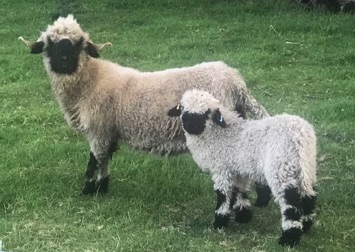
One of the features of the campsite was that it was very close to Hadrians Wall, which runs east-west very close to the England-Scotland border. We discussed this with the farmer, who gave us directions to the wall, which was only about 100 metres away. But when we got there, we could not find the wall! The farmer explained that over the centuries, parts of the wall had been dismantled stone-by-stone by local farmers, and re-used for other purposes. Indeed, he said that his house and garden featured some other walls that were constructed with stones that had been nicked from Hadrians Wall! So I guess we just saw Hadrians Ditch, rather than Hadrians Wall.
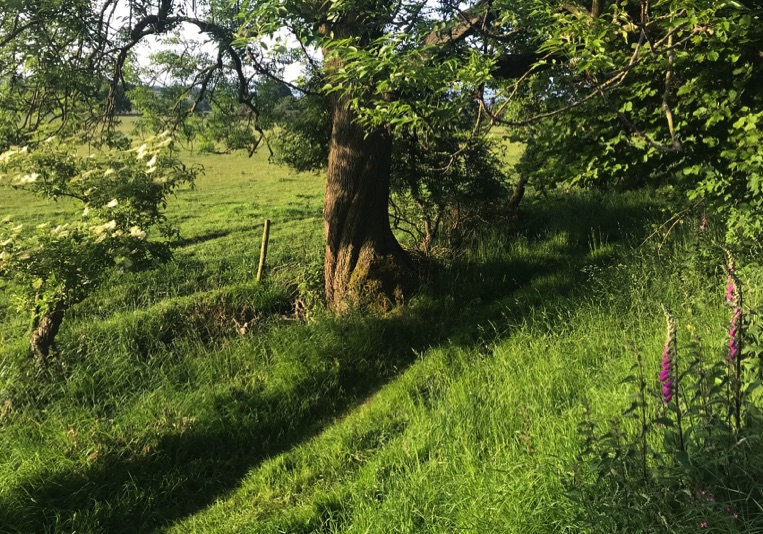
During the evening we started to make plans for the next part of our trip, which was to venture into Scotland. We got in touch again with ex-barging friends Greg and Bridget Patmore, who were sailing in the coastal waters of south-west Scotland, and made arrangements for meeting up with them tomorrow. So, only one more sleep before Scotland!